Bellarmine University
Bellarmine University (BU; /ˈbɛlərmɪn/ BEL-ər-min) is a private Catholic university in Louisville, Kentucky. The liberal arts institution opened on October 3, 1950, as Bellarmine College, established by Archbishop John A. Floersh of the Archdiocese of Louisville and named after the Cardinal Saint Robert Bellarmine.[1] In 2000 the Board of Trustees changed the name to Bellarmine University. The university is organized into seven colleges and schools and confers bachelor's and master's degrees in more than 50 academic majors, along with five doctoral degrees;[5] it is classified among "D/PU: Doctoral/Professional Universities."[6]
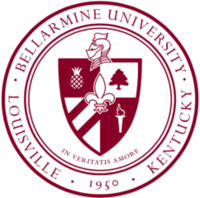 | |
Former names | Bellarmine College[1] |
|---|---|
| Motto | In Veritatis Amore |
Motto in English | In the Love of Truth |
| Type | Private |
| Established | 1950 |
Religious affiliation | Roman Catholic |
| Endowment | $52 million[2] |
| President | Dr. Susan M. Donovan |
Administrative staff | 240[3] |
| Students | 3,973[4] |
| Undergraduates | 2,635[4] |
| Postgraduates | 1,338[4] |
| Location | , , United States |
| Campus | Urban 135 acres (0.55 km2) |
| Colors | Scarlet and Silver |
| Athletics | NCAA Division I – ASUN & ECAC (field hockey) NCAA Division I – SoCon (lacrosse) |
| Nickname | Knights |
| Affiliations | ACCU CIC NAICU Kentuckiana Metroversity |
| Mascot | Valor the Knight |
| Website | www |
 | |
The university has an enrollment of over 3,900 students on its main 135-acre (0.55 km2) academic and residential campus in Louisville's Belknap neighborhood. At its 2011 commencement, the school graduated 482 undergraduate and graduate students, contributing to a total of 780 graduates for the school year, up from 700 the previous year.[7]
Bellarmine offers a large number of extracurricular activities to its students, including athletics, honor societies, clubs and student organizations. Its athletic teams are known as the Knights. Bellarmine is a member of NCAA Division I and competes in the Atlantic Sun Conference, except in men's lacrosse, which competes in the Southern Conference. Bellarmine's men's basketball team won the 2011 NCAA Men's Division II Basketball Tournament,[8] the first athletic national championship in school history.[9] Alumni and former students have gone on to prominent careers in government, business, science, medicine, education, sports, and entertainment.
History
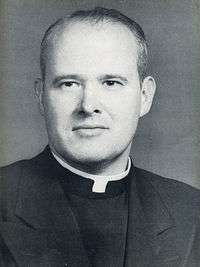
Early history
Bellarmine University has been led by four presidents: Msgr. Alfred Horrigan (1950–1972), Dr. Eugene V. Petrik (1973–1990), Dr. Joseph J. McGowan (1990–2016) and Susan M. Donovan (2017–present). Horrigan, elevated to Domestic Prelate by the pope in 1955, led the school during its formative years. Petrik strengthened Bellarmine's financial footing.[10] McGowan led the school in a massive building program, culminating in his Vision 2020 plan. Fr. Raymond J. Treece[11] served as interim president in 1972–73, between Presidents Horrigan and Petrik. Dr. John Oppelt[12] served as acting president during McGowan's sabbatical in 1999.[13]
The first public announcement of the establishment of Bellarmine College was made in November 1949 by the Archbishop of Louisville, John A. Floersh.[1] He selected Horrigan and Treece, associate editors of the Louisville Archdiocesan newspaper, The Record, to begin the school.[13] The two designed a curriculum and the school's core philosophy, taking cues from The Catholic University of America in Washington, DC, and seeking advice from a number of Catholic institutions, including the University of Notre Dame, the University of Scranton, and the University of St. Thomas in Houston, Texas.[13]
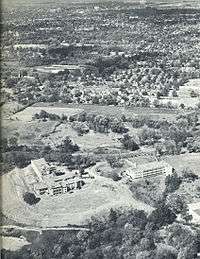
In 1950, The Catholic Archdiocese of Louisville founded Bellarmine College with a pioneer class of 115 freshmen.[1] The only building, Pasteur Hall, was still without its front door on the first day of classes.[13] Archbishop John A. Floersh called the school into existence at its first Convocation, saying, "We are looking forward to the day when the college ranks with the great colleges of our country."[13] From its opening day under founding President Horrigan, Bellarmine welcomed people of all faiths and races.[1] In 1953 the college added the Administration Building (now Horrigan Hall). At its first commencement in 1954, Bellarmine graduated 42 students.[1] The Korean War interrupted or ended the educations of many in the pioneer class, but the school persevered despite rumors of closure. In December 1956, the Southern Association of Colleges and Schools formally announced Bellarmine's accreditation.[1] Enrollment rose from the initial 115 in 1950 to 1,033 in 1959.[13]
Expansion and growth
The 1960s was an era of growth for the university. The university added Knights Hall, Bonaventure Hall, Lenihan Hall, Newman Hall, Kennedy Hall, an addition to Pasteur Hall and a small student activities building.[13] 1963 witnessed the arrival of students from 17 states and two foreign countries.[13] In 1964 the school awarded its 1,000th diploma.[13] By the end of the decade enrollment exceeded 2,000 and the college installed its first computer.[13]
In 1967, Thomas Merton designated Bellarmine as the official repository of all his manuscripts leading to the formation of Bellarmine's Catholic identity in the inclusive Merton spirit.[14] And in 1968, Bellarmine College merged with Ursuline College, becoming coeducational and independent of the Archdiocese.[13] The school now had its own self-perpetuating Board of Trustees.[13]
In May 1971, President Horrigan issued a report describing the state of Bellarmine College, especially in light of the Second Vatican Council, noting that the school's board of trustees consisted of representatives from a number of groups, reflecting the "open, progressive, ecumenical and experimental spirit" of that papal council.[13] Also mentioned were various distinctions Bellarmine's students had achieved, including 14 Woodrow Wilson Fellowships, seven National Science Foundation Fellowships, three Fulbright Scholars, two Danforth Fellowships[15] and two East-West Fellowships,[16] achievements he attributed to Bellarmine's commitment to excellence.[13]
The college welcomed its second president when Horrigan resigned in 1972. His vice president, Fr. Raymond J. Treece, served as interim president for one year. Enrollment had fallen sharply, to 1,306 by 1973, and several years of deficit budgets put the school at risk of closure. The Board of Trustees appointed Dr. Eugene V. Petrik of California to the presidency in 1973 and he quickly began to revitalize the college with new programs and directions. He added the first graduate program – the MBA in 1975 – found resources for marketing and publicity, and brought enrollment back above 2,000.[1] The school also added women's basketball in 1973, and men's soccer and women's volleyball in 1976.[13]
The 1980s saw another decade of growth. Enrollment rose from 2,284 to 2,660. The Brown Activities Center (named for George G. Brown), Wyatt Center for the Arts (named for Wilson W. Wyatt), Norton Fine Arts Complex (named for Jane Morton Norton), Alumni Hall (Humanities Building), and Maurice D.S. Johnson quadrangle (named for former board chair) were added during these years, along with the W. Fielding Rubel School of Business and the Donna and Allan Lansing School of Nursing and Health Sciences (1984). The subject of changing the name of the school from Bellarmine College to Bellarmine University was broached, but it was decided that the school should become a university in fact before it became one in name. More opportunities were added for women to participate in athletics, including softball, track, cross country, tennis and field hockey. A $20 million capital campaign propelled the college into the 1990s.
Recent history
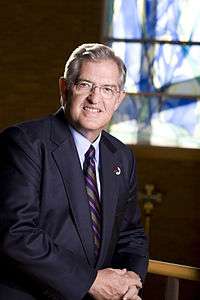
Dr. Joseph J. McGowan, became Bellarmine's third president in 1990. McGowan named buildings on campus for his predecessors, Horrigan and Petrik, and oversaw the addition of Miles Hall and the W.L. Lyons Brown Library.[17] The Annsley Frazier Thornton School of Education was added in 1998, study abroad jumped from seven students in 1995 to 70 in 1999, and the school added women's soccer and women's golf. The decade also saw the beginning of Bellarmine's transition from a commuter school to a residential college. In 1995, a record 396 students lived in residence halls. McGowan sought to make Bellarmine "the region's premier residential liberal arts college", citing Stanford University, Vanderbilt University, and Duke University as models.[17] In 1991, McGowan began instituting change in the form of a Five Year Strategic Plan, which later became the Master Plan.[17] In 1994, the school began making perennial appearances in the Princeton Review and U.S. News and World Report, which both list Bellarmine among the top regional universities.[18][19]
In 2000, the school's 50th anniversary, the Board of Trustees changed the name from Bellarmine College to Bellarmine University to reflect its status as a Masters-I university.[1] In 2005, McGowan announced Vision 2020, the university's plan to become "the premier Independent Catholic University in the South, and thereby the leading private institution in the Commonwealth and region."[20] Among other things, the plan calls for tripling enrollment, doubling the number of buildings on campus, and adding schools of architecture, law, pharmacy, and veterinary medicine by 2020.[21] In addition, the possibility of moving the remaining athletic programs to NCAA Division I (joining lacrosse) will be considered.[17] Under McGowan's leadership, a construction, acquisition and renovation boom that continues still today included Our Lady of the Woods Chapel, The President's Residence in Glenview, the 2120 Building, the Norton Health Sciences Center (named in honor of Norton Healthcare support), The Siena Residence Halls complex, Owsley B. Frazier Stadium, Joseph A. and Janet P. Clayton Field, Via Cassia and Ponte Juneja, and the expansion of Miles Hall. Enrollment reached a record 2,881 students by 2009, with more than 700 in residence on the campus, and the average ACT score of entering Bellarmine students reached a record high. Bellarmine launched many new academic programs including The School of Continuing and Professional Studies, the Institute of Media, Culture and Ethics and the School of Communication, The Center for Regional Environmental Studies and Bellarmine Farm.

Growth at the university includes 20 new academic programs, a 60% increase in full-time enrollment and a 56% increase in the number of residential students. The 135-acre (0.55 km2) campus was expanded from 15 buildings in 1990 to 40 buildings, winning 11 architectural awards. Future plans include a new life fitness and recreation center with an Olympic pool, and Bellarmine Centro, a campus center to be anchored by an extensively remodeled Horrigan Hall connected to three new buildings.[22]
McGowan died on March 1, 2016. Bellarmine's executive vice president, Dr. Doris Tegart, was appointed the university's interim president, with a national search planned for a new president.[23]
In February 2017, the Board of Trustees unanimously selected Susan M. Donovan as the university's fourth president. She assumed the presidency on June 1, 2017, following a long career at Loyola University Maryland.[24]
Academics
| University rankings | |
|---|---|
| National | |
| ARWU[25] | Not Ranked |
| Forbes[26] | 224[27] |
| U.S. News & World Report[28] | 11 (southern US)[27] |
| Washington Monthly[29] | 76[30] |
| Global | |
| ARWU[31] | Not Ranked |
| QS[32] | Not Ranked |
| THE[33] | Not Ranked |
Bellarmine is accredited by the Southern Association of Colleges and Schools (SACS).[34] The Bellarmine W. Fielding Rubel School of Business is one of a select few to receive AACSB accreditation.[35] Bellarmine offers more than 50 majors in the arts and sciences, business, communication, education, nursing and health sciences[36][37] The university comprises seven colleges and schools.[1][38]
Bellarmine also offers a study abroad program,[39] and during the summer months, the university hosts Kentucky's Governor's Scholar Program.[40]
Colleges and schools
Bellarmine College of Arts & Sciences
Donna and Allan Lansing School of Nursing and Health Sciences
W. Fielding Rubel School of Business
Annsley Frazier Thornton School of Education
In 1998, Bellarmine's department of education was dedicated as the "School of Education." Three years later in 2001 it was named the Annsley Frazier Thornton School of Education (AFTSE). The school offers 20 different programs, including a doctorate in education and social change.[41]
School of Communication
The School of Communication was added in 2009 after Bellarmine created the Institute for Media, Culture and Ethics in 2007, and added the Master of Arts in communication in 2008.[42] Areas of study offered at the school include graphic design, sports broadcasting, journalism and new media writing, and advertising and public relations.[43] The school has about 200 students.[44]
School of Environmental Studies
The environmental studies major was upgraded to the School of Environmental Studies in 2013.[45] The school offers a Bachelor of Arts and a Bachelor of Science as well as a minor.[46] It is the only undergraduate program in environmental studies in Louisville.[47]
School of Continuing and Professional Studies
Study abroad
Bellarmine offers study abroad options on six continents in over 50 countries around the globe, ranging from departmental programs to summer enclave programs and semester or academic year exchanges at over 150 partner universities.[48][49] Study abroad is available not only for foreign language students but for all other academic areas as well, and it is accessible to all students regardless of social and economic background. More than 35% of Bellarmine's full-time students engage in an international experience during their tenure at Bellarmine.[49]
Campus facilities
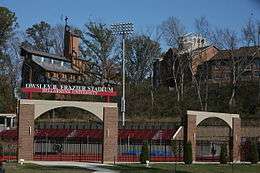
Over 40 buildings stand on the hills of Bellarmine's 135-acre (0.55 km2) campus in Louisville's Belknap neighborhood, at the western edge of the larger Highlands area.
The Owsley B. Frazier Stadium
The multi-purpose stadium serves as home to Bellarmine's soccer, field hockey, lacrosse, and track and field teams. The stadium opened on August 24, 2007 in a Bellarmine Knights women's soccer game, and was officially dedicated on August 28.[50] Construction took approximately 18 months and cost $5.1 million.[50] The stadium features Joseph P. and Janet A. Clayton Field, which is composed of artificial turf with permanent markings for soccer, field hockey and lacrosse games. Surrounding the field is an eight-lane, 400 meter track. The track has a dual-durometer, polyurethane poured surface provided by Beynon Sport Surfaces, a company that has installed tracks at other college facilities including Illinois, Maryland, and Purdue.[50]
Our Lady of The Woods Chapel
The chapel was dedicated on May 11, 2001, as a place of worship for Bellarmine students.[51][52] Made of glass, wood, and steel, the chapel stands in memory of Archbishop of Louisville John A. Floersh, who founded Bellarmine in 1950.[52] The interior building has two large stained glass windows, designed by Guy Kemper, an artist from Lexington, KY. The surrounding community celebrates Mass in the chapel on Sundays and holy days, and uses the chapel for retreats and interfaith services. Because it does not have parish status, its use is restricted. No weddings, baptisms, or funerals are held there.[51] There is no "Our Lady of the Woods" in Catholic tradition. The statue in the chapel is actually Our Lady of Grace. Bellarmine College's earliest administrators had a particular devotion to Mary and suggested the chapel be named for her. Because of its setting, the chapel committee chose the name "Our Lady of the Woods."[51][52]
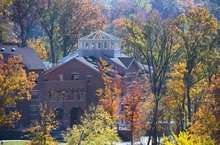
Siena Complex
The Siena Complex is composed of four residence halls: Siena Primo, Siena Secondo, Siena Terzo and Siena Quarto. The complex is modeled after the Piazza del Campo, the main town center of Siena, Italy. Bellarmine's namesake, St. Robert Bellarmine, was a native of Tuscany, where Siena is.[53] The Siena buildings were built by F.W. Owens Co. Inc. and designed by Godsey Associates Architects Inc. They have private restrooms, wireless Internet access, kitchens, balconies, laundry facilities, group study spaces, lobby gathering areas, and a 200-seat dining hall. When completed, the four buildings will enclose a landscaped courtyard with fountains, a small amphitheater and possibly bocce courts.[53] The Siena Housing Project is a project to have half of the school's undergraduate population live on campus.[54][55] Cumulatively, the Siena Complex will house 519 students and cost $33.6 million.[53]
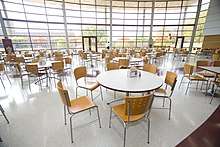
University Dining Hall
In 2010 Bellarmine opened a new 540-seat, 21,500-square-foot (2,000 m2) dining hall. It features indoor and outdoor seating areas with a 25-foot (7.6 m) tall panoramic window that provides natural light and view of rolling hills. It was built as part of a $7.5 million overhaul of the George G. Brown Center, which also includes a renovated and expanded School of Communication and the Amelia Brown Frazier Convocation Hall. The dining hall is managed by Sodexo Inc., which operated the previous cafeteria.[56]
Knights Hall
Knights Hall is home to Bellarmine basketball and volleyball teams. The arena was built in 1960 and can seat up to 2,600 fans.[57] It is also used for high school games, graduation ceremonies, and concerts. The hall was dedicated in 1960 with a home game against the University of Louisville and has hosted matchups with rival and NAIA national champion Kentucky State, Fly Williams and his teams from Austin Peay, and the Knights women's basketball regional championship games of the 1990s.[57] The arena has also hosted some very special guests including Mother Teresa, the Grateful Dead, Jimmy Buffett and Pete Rose, among others. In 2007, Knights Hall was featured on ESPN when NBA greats such as Bill Walton, Darrell Griffith, and Kenny Walker judged the McDonald's High School All-American Slam Dunk Contest.[57]
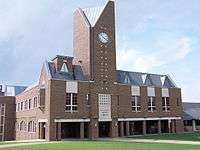
The W.L. Lyons Brown Library
The campus library was completed in the fall of 1996, costing $6.5 million. Its exterior is made up of brown brick, anodized aluminum-frame windows and slate roofs. It has long spanning brick arches with vertical piers, limestone columns and banding, steep sloping roofs, and a clock tower marking the entry, establishing a focal point on campus.[58]
The library supports 150,000 volumes and includes a print and electronic-based reference center, micro forms, media services, periodicals, general collections, and a special-collections center. It houses the campus computer center and is wired throughout to promote flexibility in computer usage.[58]
Eddie Weber Tennis Complex & SuRF Center
The Eddie Weber Tennis Complex was dedicated on September 12, 2009, and is adjacent to the Student Recreation and Fitness Center (SuRF).[59] The courts are named for Eddie Weber, the only man to have been a head coach for both the University of Louisville and Bellarmine.[60] The complex houses 6 outdoor tennis courts with 3 additional indoor courts in the SuRF Center. Inside the SuRF Center are two multi-purpose basketball courts, the exercise and fitness area, locker rooms, and offices. The fitness area is supplied with treadmills, bikes, elliptical weight machines, and free weights.[59]

Norton Health Science Center
Bellarmine's main science and research facility is the Norton Health Science Center (NHSC).[61] NHSC was completed in 2004 and has 30,000 sq ft (2,800 m2) of floor space.[62] The floor space is divided into laboratories, faculty offices and classrooms.[61] The facility also includes a courtyard for the science quadrangle and an animal holding facility for the Psychology Department.[62] NHSC cost $6.5 million to build and was funded primarily by private donations.[61]
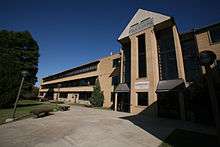
Horrigan Hall
Horrigan Hall is named after the university's first president, Msgr. Alfred Horrigan, and serves as the campus center.[63] Architects Thomas J. Nolan & sons designed the facility in "modern" 1950s style and Al J. Schneider Company was the general contractor.[13] The exterior is of rough textured brick with limestone trim. The three-story building sits atop a hill on campus featuring a six-story tower. Originally known as the Administration Building, Horrigan Hall was constructed in February 1953, costing $1 million.[13] The facility was completely funded by private donations.[13] Horrigan Hall has gone through a few remodeling and upgrades over the years. In December 1961 a new sound system was added, with central air following in 1970.[13] In 1986–87 an elevator was installed and a new 2001 Newburg Road entrance was added as an alternative to the original 2000 Norris Place street entrance.[13] Further remodeling and expansion is planned. Three new buildings have been proposed in front of and connected to the existing hall.[64] The project is dubbed "Bellarmine Centro" and calls for the addition of more than 65,000 square feet (6,000 m2) of new space and approximately 39,000 square feet (3,600 m2) of remodeled space in the existing building.[64] There will be space for a new Graduate School of Management, bookstore, admissions, registrar, bursar and financial aid offices.[64] Classrooms will be added and expanded and a new space dedicated to triple the size of the Thomas Merton Center, the official repository of Merton's manuscripts, which hosts approximately 3,000 research international scholars and visitors annually.[64] A garden and green space will be added, including a green roof accessible to students and faculty. Bellarmine Centro is estimated to cost $38 million and will be funded entirely by private sources.[64]
Athletics
Bellarmine's athletic teams are known as the Knights. The university competes at the NCAA Division I level as members of the Atlantic Sun Conference for most sports.[65]
Bellarmine sponsors five sports that are not sponsored by its future league. The men's lacrosse team, the only NCAA Division I lacrosse team in Kentucky, is a member of the Southern Conference, and will remain in that league after joining the ASUN. Men's and women's swimming and diving will join the Coastal Collegiate Sports Association upon the Knights' arrival in the ASUN. The field hockey (women) and wrestling (men) teams will become D-I independents.[65]
In 2011 the Knights won the NCAA Men's Division II Basketball Championship.[8] In 2015, the Bellarmine University Dance Team won their first national title at the 2015 NDA collegiate championship. In 2019, the team won their second national title at the 2019 NDA collegiate championship.[66][67] In 2012 Bellarmine announced the start of its swimming program. The university's newest sport is wrestling, added for the 2016–17 school year; Bellarmine effectively absorbed the wrestling program of St. Catharine College, an NAIA member that closed at the end of the 2015–16 school year.[68] It is the first NCAA wrestling program in the state of Kentucky.
|
|
- The NCAA officially considers indoor and outdoor track & field to be two separate sports, holding its indoor championships in its winter season and outdoor championships in its spring season.
Honorary societies
- Phi Alpha Theta (History)
- Lambda Pi Eta (Communications)
- Pi Sigma Alpha (Political Science)
Notable people
Alumni
- John Young Brown III, Secretary of State of Kentucky from 1996 to 2004[69]
- Joseph C. Burke, former President of State University of New York at Plattsburgh; former Acting Chancellor of the State University of New York[70]
- Susan Cameron, Reynolds American CEO; former CEO at Brown & Williamson Tobacco Corporation[71]
- Joseph P. Clayton, former President & CEO, DISH Network; former CEO and chairman of Sirius Satellite Radio, Inc.[72]
- William J. Donahue, retired Lieutenant General for the United States Air Force[73]
- Kelly Downard, Louisville Metro Council member (16th District) (2006)[74]
- Chris Dowe, professional basketball player
- Shawn Evans, National Lacrosse League (NLL) player[75] and 2013 NLL MVP[76]
- Dapo Fagbenle, London-based music video director and entertainer
- Braydon Hobbs, professional basketball player
- Jeremy Kendle, professional basketball player
- Quentin Letts, journalist
- John MacLeod, veteran NBA coach[77]
- Kyle Sorensen, National Lacrosse League player[78]
- Frank L. Schmidt, psychologist
- Bruce Tinsley, syndicated cartoonist and creator of the Mallard Fillmore comic strip[79]
- Todd Wellemeyer, Major League Baseball player[80]
Faculty
- Jerry Abramson, Former Executive-in-residence, former Mayor of Louisville Metro, former Lieutenant Governor of Kentucky, and former White House Director of Intergovernmental Affairs[81][82]
Radio station
Bellarmine University has a radio station named Bellarmine Radio, catering mainly to the campus community. Initially, the radio station broadcast via a radio frequency, but, in 2005, it began to broadcast as an online radio station. Bellarmine Radio provides daily announcements about events on campus, extended coverage of Bellarmine athletics, and a variety of specialty shows.[83]
References
- "History of Bellarmine University". Bellarmine University. Archived from the original on December 13, 2010. Retrieved January 17, 2011.
- "Bellarmine Magazine, Winter 2015". December 19, 2014. Retrieved December 23, 2014.
- "Fast Facts: Bellarmine University FY 2009 to FY 2010". University and College Accountability Network U-CAN. University and college Accountability Network U-CAN. Retrieved May 9, 2011.
- As of fall 2016. "Student headcount by level: All independent institutions (2006-16)" (PDF). Kentucky Council on Postsecondary Education. Commonwealth of Kentucky. Retrieved March 4, 2018.
- "Majors and Programs". Bellarmine University. Retrieved October 25, 2016.
- "The Carnegie Classification of Institutions of Higher Education – Bellarmine University". Center for Postsecondary Research, Indiana University, Bloomington. 2008–2010. Retrieved January 25, 2016.
- Shepherd, Andrea (May 14, 2011). "Bellarmine sets Record with 780 Graduates". The Courier-Journal. Archived from the original on April 8, 2013. Retrieved May 24, 2011.
- Haeberle, Bennett (March 26, 2011). "Bellarmine Knights win Div. II basketball title". WDRB. Archived from the original on July 25, 2011. Retrieved June 15, 2011.
- Jung, Chris (March 24, 2011). "Bellarmine Will Play For National Title". Catholic Sports Net. Retrieved June 15, 2011.
- "Dr. Eugene V. Petrik". Bellarmine University. Archived from the original on December 6, 2010. Retrieved May 19, 2011.
- "Heritage Society Scholarships – Fr. Raymond J. Treece Endowed Chair of Accounting". Bellarmine University. Archived from the original on July 27, 2011. Retrieved March 31, 2017.
- "2004 Alumni Awards announced". bellarmine.edu.
- Hall, Wade (1999). High Upon a Hill. Louisville: Bellarmine College Press. pp. 1–317. ISBN 0-9638927-2-X.
- Erickson, Lori. "Spirit Travels". Word Press. p. 1. Retrieved May 17, 2011.
- "'To Promote the Well-Being of Mankind': A Brief History of the Danforth Foundation" (PDF). Retrieved March 31, 2017.
- "Scholarships / Fellowships". eastwestcenter.org.
- Ward, Joe (June 2006). "Big Plan On Campus". Louisville Magazine. Archived from the original on July 13, 2011. Retrieved January 17, 2011.
- "Bellarmine University". The Princeton Review. 2010. Archived from the original on January 6, 2011. Retrieved January 17, 2011.
- "Bellarmine University – Best Colleges – Education – US News and World Report". U.S. News & World Report. August 17, 2010. Retrieved January 17, 2011.
- "Vision 2020 Imagine. Believe. Create". Bellarmine University. 2006. Archived from the original on December 5, 2010. Retrieved January 17, 2011.
- Staff (April 23, 2008). "Bellarmine receives $2.5M gift from family of Nolen Allen". Business First of Louisville. Retrieved January 17, 2011.
- "What impact will Bellarmine's new Centro facility have on the campus? – Louisville – Louisville Business First". Retrieved May 27, 2015.
- Clark, Kirsten (March 15, 2016). "Bellarmine names interim president". The Courier-Journal. Retrieved January 30, 2017.
- "Office of the President". Bellarmine University.
- "Academic Ranking of World Universities 2020: National/Regional Rank". Shanghai Ranking Consultancy. Retrieved August 15, 2020.
- "America's Top Colleges 2019". Forbes. Retrieved August 15, 2019.
- "Bellarmine University Rises in National Rankings". Bellarmine University. Retrieved July 11, 2013.
- "Best Colleges 2020: National University Rankings". U.S. News & World Report. Retrieved September 8, 2019.
- "2019 National University Rankings". Washington Monthly. Retrieved August 20, 2019.
- "Master's University Ranking WM". Washington Monthly. 2010. Archived from the original on June 5, 2011. Retrieved June 14, 2011.
- "Academic Ranking of World Universities 2020". Shanghai Ranking Consultancy. 2020. Retrieved August 15, 2020.
- "QS World University Rankings® 2021". Quacquarelli Symonds Limited. 2020. Retrieved June 10, 2020.
- "World University Rankings 2020". THE Education Ltd. Retrieved September 14, 2019.
- "Institutional Accreditation". U.S. Department of Education Institute of Education Sciences. Retrieved March 10, 2011.
- "AACSB: Bellarmine University, W. Fielding Rubel School of Business". AACSB. 2010. Retrieved May 13, 2011.
- "Bellarmine University". Hakes International. Archived from the original on March 25, 2012. Retrieved June 15, 2011.
- "Bellarmine Academics". Bellarmine University. Archived from the original on May 21, 2011. Retrieved June 15, 2011.
- "Bellarmine University Schools". Bellarmine University. Archived from the original on December 5, 2010. Retrieved January 17, 2011.
- "Study Abroad Programs". www.bellarmine.edu. Retrieved June 3, 2015.
- "Governor's Scholars Program :: Bellarmine University :: Information". www.bellarmine.edu. Archived from the original on May 26, 2015. Retrieved May 22, 2015.
- "Annsley Frazier Thornton School of Education". www.bellarmine.edu. Retrieved June 3, 2015.
- "Bellarmine Board of Trustees Approves New School of Communication". www.bellarmine.edu. Retrieved June 3, 2015.
- "School of Communication". www.bellarmine.edu. Retrieved June 3, 2015.
- "Bellarmine names building after Dish president". Retrieved June 3, 2015.
- "Bellarmine University Creates New School of Environmental Studies – 89.3 WFPL". Retrieved June 3, 2015.
- "Environmental Studies". www.bellarmine.edu. Archived from the original on June 29, 2015. Retrieved June 3, 2015.
- "School of Environmental Studies". www.bellarmine.edu. Retrieved June 3, 2015.
- "Study Abroad Programs". Bellarmine University. Retrieved June 14, 2011.
- "International Studies". Bellarmine University. Archived from the original on May 21, 2011. Retrieved June 14, 2011.
- "Ready to Unveil $5.1 Million stadium". Bellarmine University. August 16, 2007. Archived from the original on July 27, 2011. Retrieved June 2, 2011.
- "Our Lady of The Woods Chapel". Bellarmine University. Archived from the original on July 27, 2011. Retrieved June 3, 2011.
- "Our Lady of The Woods Chapel (Tribute Pamphlet)". Bellarmine University. Retrieved June 3, 2011.
- Karman, John R. III (September 6, 2010). "Fourth dorm finishes Bellarmine's $33.6 million housing project Read more: Fourth dorm finishes Bellarmine's $33.6 million housing project". Business First. Retrieved June 2, 2011.
- Staff (September 2010). "Fourth dorm finishes Bellarmine's $33.6 million housing project". Business First of Louisville. Retrieved May 13, 2011.
- "Siena". Bellarmine University. Archived from the original on July 27, 2011. Retrieved June 2, 2011.
- Staff (October 13, 2010). "New dining hall opens at Bellarmine". Business First of Louisville. Retrieved May 13, 2011.
- "Knights Hall". Bellarmine University. Retrieved June 3, 2011.
- "Bellarmine College, The W.L. Lyons Brown Library". SchoolDesigns.com. Retrieved May 24, 2011.
- "Eddie Weber Tennis Complex and SuRF". Bellarmine University. Retrieved June 3, 2011.
- Cox, Earl (April 6, 2011). "Davenport Sets The Bar High". The Voice-Tribune. Archived from the original on February 9, 2013. Retrieved June 3, 2011l.
- "Selected STEM Pipeline Initiatives at Kentucky's Independent Colleges and Universities" (PDF). Alice-Lloyd College. February 2007. Archived from the original (PDF) on July 24, 2011. Retrieved June 3, 2011.
- "The Norton Health Science Center". vbnarchitects.com. January 21, 2004. Archived from the original on September 1, 2011. Retrieved June 3, 2011.
- "Monsignor Alfred Horrigan". Bellarmine University. Archived from the original on July 27, 2011. Retrieved June 6, 2011.
- Spungnardi, John. "Bellarmine receives $3 million from James Graham Brown Foundation". Bellarmine University. Retrieved June 6, 2011.
- "ASUN Conference Announces Addition of Bellarmine University" (Press release). ASUN Conference. June 18, 2019. Retrieved June 18, 2019.
- "Dance Team captures NDA National Championship".
- "Bellarmine Dance Team captures national championship".
- "Bellarmine to start men's wrestling team" (Press release). Bellarmine Knights. June 14, 2016. Retrieved October 20, 2016.
- "Secretaries of State". apps.sos.ky.gov. Archived from the original on May 18, 2015. Retrieved May 11, 2015.
- "Joseph Charles Burke (CV)" (PDF). rockinst.org. Archived from the original (PDF) on March 8, 2016. Retrieved January 25, 2016.
- "Susan Ivey". forbes.com. Retrieved May 11, 2015.
- "DISH Network President and CEO Joseph P. Clayton to Retire March 31, 2015 | About DISH". about.dish.com. Retrieved May 13, 2015.
- "William J. Donahue Lieutenant General USAF (Ret): Executive Profile & Biography – Businessweek". Businessweek.com. Retrieved May 13, 2015.
- "About Kelly Downard | LouisvilleKy.gov". louisvilleky.gov. Archived from the original on May 18, 2015. Retrieved May 11, 2015.
- "Former Knight Evans named NLL's Most Valuable Player". Bellarmine. Retrieved May 18, 2015.
- "Shawn Evans". Retrieved May 18, 2015.
- "NBA.com: COACHES". www.nba.com. Retrieved May 13, 2015.
- "Bellarmine Lacrosse 2006 Roster, Schedule, and Stats". lax.com. Archived from the original on May 18, 2015. Retrieved May 13, 2015.
- "Dr. Margaret Mahoney guest-stars in comic strip". Bellarmine Magazine: 15. Summer 2011. Retrieved January 25, 2016.
- "Todd Wellemeyer". ESPN.com. Retrieved May 13, 2015.
- "Louisville Mayor Jerry Abramson Joins Bellarmine University as Executive-in-Residence in 2011". www.bellarmine.edu. Retrieved May 13, 2015.
- Wallace, James (January 30, 2015). "Jerry Abramson relishes White House policy role". The Courier-Journal. Retrieved July 31, 2015.
- "Bellarmine Radio". bellarmineradio.com. Retrieved October 25, 2018.